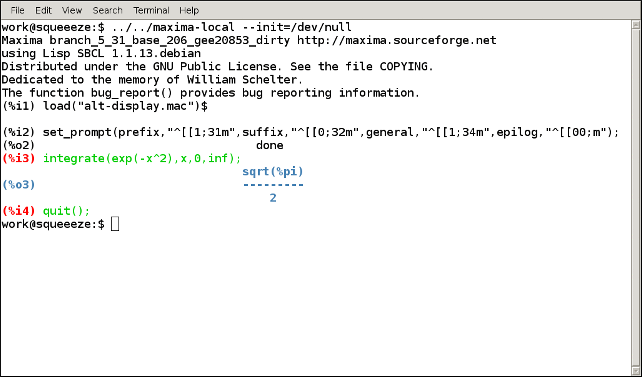Previous: Introduction to alt-display, Up: alt-display [Contents][Index]
39.2 Functions and Variables for alt-display
- Function: alt_display_output_type (form) ¶
-
Determine the type of output to be printed. Form must be a lisp form suitable for printing via Maxima’s built-in
displafunction. At present, this function returns one of three values: text, label or unknown.An example where
alt_display_output_typeis used. Inmy_display, a text form is printed between a pair of tags TEXT;>> and <<TEXT; while a label form is printed between a pair tags OUT;>> and <<OUT; in addition to the usual output label.The function
set_promptalso ensures that input labels are printed between matching PROMPT;>> and <<PROMPT; tags.Thanks to Eric Stemmler.
(%i1) (load("mactex-utilities"), load("alt-display.mac")) $ (%i2) define_alt_display(my_display(form), block([type,txttmplt,labtmplt], txttmplt:"~%TEXT;>>~%~a~%<<TEXT;~%", labtmplt:"~%OUT;>>~%(~a) ~a~a~a~%<<OUT;~%", type:alt_display_output_type(form), if type='text then printf(true,txttmplt,first(form)) else if type='label then printf(true,labtmplt,first(form),"$$",tex1(second(form)),"$$") else block([alt_display1d:false, alt_display2d:false], displa(form)))) $ (%i3) (set_prompt('prefix, "PROMPT;>>",'suffix, "<<PROMPT;"), set_alt_display(1,my_display)) $ PROMPT;>>(%i4) <<PROMPT;integrate(x^n,x); PROMPT;>> TEXT;>> Is n equal to -1? <<TEXT; <<PROMPT; n; OUT;>> (%o4) $$\frac{x^{n+1}}{n+1}$$ <<OUT; PROMPT;>>(%i5) <<PROMPT;Categories: Package alt-display ·
- Function: define_alt_display (function(input), expr) ¶
This function is similar to
define: it evaluates its arguments and expands into a function definition. The function is a function of a single input input. For convenience, a substitution is applied to expr after evaluation, to provide easy access to Lisp variable names.Set a time-stamp on each prompt:
(%i1) load("alt-display.mac")$ (%i2) display2d: false$ (%i3) define_alt_display(time_stamp(x), block([alt_display1d:false,alt_display2d:false], prompt_prefix:printf(false,"~a~%",timedate()), displa(x))); (%o3) time_stamp(x):=block( [\*alt\-display1d\*:false, \*alt\-display2d\*:false], \*prompt\-prefix\* :printf(false,"~a~%",timedate()),displa(x)) (%i4) set_alt_display(1,time_stamp); (%o4) done 2017-11-27 16:15:58-06:00 (%i5)The input line
%i3definestime_stampusingdefine_alt_display. The output line%o3shows that the Maxima variable namesalt_display1d,alt_display2dandprompt_prefixhave been replaced by their Lisp translations, as hasdisplabeen replaced by?displa(the display function).The display variables
alt_display1dandalt_display2dare both bound tofalsein the body oftime_stampto prevent an infinite recursion indispla.Categories: Package alt-display ·
- Function: info_display (form) ¶
This is an alias for the default 1-d display function. It may be used as an alternative 1-d or 2-d display function.
(%i1) load("alt-display.mac")$ (%i2) set_alt_display(2,info_display); (%o2) done (%i3) x/y; (%o3) x/yCategories: Package alt-display ·
- Function: mathml_display (form) ¶
Produces MathML output.
(%i1) load("alt-display.mac")$ (%i2) set_alt_display(2,mathml_display); <math xmlns="http://www.w3.org/1998/Math/MathML"> <mi>mlabel</mi> <mfenced separators=""><msub><mi>%o</mi> <mn>2</mn></msub> <mo>,</mo><mi>done</mi> </mfenced> </math>Categories: Package alt-display ·
- Function: tex_display (form) ¶
Produces TeX output.
(%i2) set_alt_display(2,tex_display); \mbox{\tt\red({\it \%o_2}) \black}$$\mathbf{done}$$ (%i3) x/(x^2+y^2); \mbox{\tt\red({\it \%o_3}) \black}$${{x}\over{y^2+x^2}}$$Categories: Package alt-display ·
- Function: multi_display_for_texinfo (form) ¶
Produces Texinfo output using all three display functions.
(%i2) set_alt_display(2,multi_display_for_texinfo)$ (%i3) x/(x^2+y^2); @iftex @tex \mbox{\tt\red({\it \%o_3}) \black}$${{x}\over{y^2+x^2}}$$ @end tex @end iftex @ifhtml @html <math xmlns="http://www.w3.org/1998/Math/MathML"> <mi>mlabel</mi> <mfenced separators=""><msub><mi>%o</mi> <mn>3</mn></msub> <mo>,</mo><mfrac><mrow><mi>x</mi> </mrow> <mrow><msup><mrow> <mi>y</mi> </mrow> <mn>2</mn> </msup> <mo>+</mo> <msup><mrow> <mi>x</mi> </mrow> <mn>2</mn> </msup> </mrow></mfrac> </mfenced> </math> @end html @end ifhtml @ifinfo @example (%o3) x/(y^2+x^2) @end example @end ifinfoCategories: Package alt-display ·
- Functions: reset_displays () ¶
Resets the prompt prefix and suffix to the empty string, and sets both 1-d and 2-d display functions to the default.
Categories: Package alt-display ·
- Function: set_alt_display (num, display-function) ¶
The input num is the display to set; it may be either 1 or 2. The second input display-function is the display function to use. The display function may be either a Maxima function or a
lambdaexpression.Here is an example where the display function is a
lambdaexpression; it just displays the result as TeX.(%i1) load("alt-display.mac")$ (%i2) set_alt_display(2, lambda([form], tex(?caddr(form))))$ (%i3) integrate(exp(-t^2),t,0,inf); $${{\sqrt{\pi}}\over{2}}$$A user-defined display function should take care that it prints its output. A display function that returns a string will appear to display nothing, nor cause any errors.
Categories: Package alt-display ·
- Function: set_prompt (fix, expr) ¶
Set the prompt prefix or suffix to expr. The input fix must evaluate to one of
prefix,suffix,general,prologorepilog. The input expr must evaluate to either a string orfalse; iffalse, the fix is reset to the default value.(%i1) load("alt-display.mac")$ (%i2) set_prompt('prefix,printf(false,"It is now: ~a~%",timedate()))$ It is now: 2014-01-07 15:23:23-05:00 (%i3)The following example shows the effect of each option, except
prolog. Note that theepilogprompt is printed as Maxima closes down. Thegeneralis printed between the end of input and the output, unless the input line ends in$.Here is an example to show where the prompt strings are placed.
(%i1) load("alt-display.mac")$ (%i2) set_prompt(prefix, "<<prefix>> ", suffix, "<<suffix>> ", general, printf(false,"<<general>>~%"), epilog, printf(false,"<<epilog>>~%")); (%o2) done <<prefix>> (%i3) <<suffix>> x/y; <<general>> x (%o3) - y <<prefix>> (%i4) <<suffix>> quit(); <<general>> <<epilog>>Here is an example that shows how to colorize the input and output when Maxima is running in a terminal or terminal emulator like Emacs8.

Each prompt string starts with the ASCII escape character (27) followed by an open square bracket (91); each string ends with a lower-case m (109). The webpages https://misc.flogisoft.com/bash/tip_colors_and_formatting and https://www.tldp.org/HOWTO/Bash-Prompt-HOWTO/x329.html provide information on how to use control strings to set the terminal colors.
Categories: Package alt-display ·